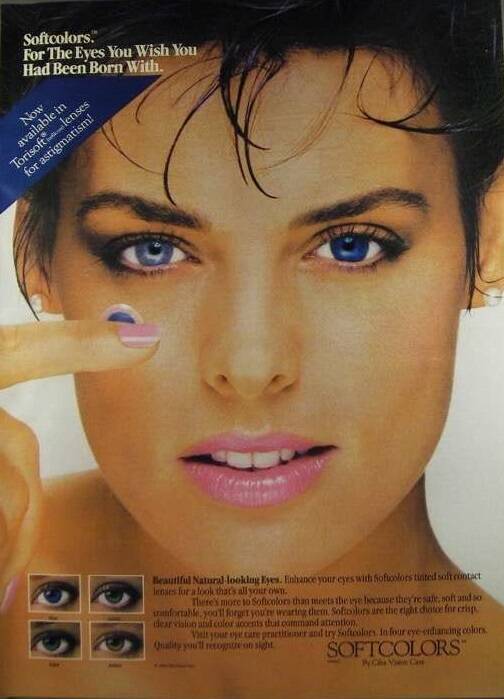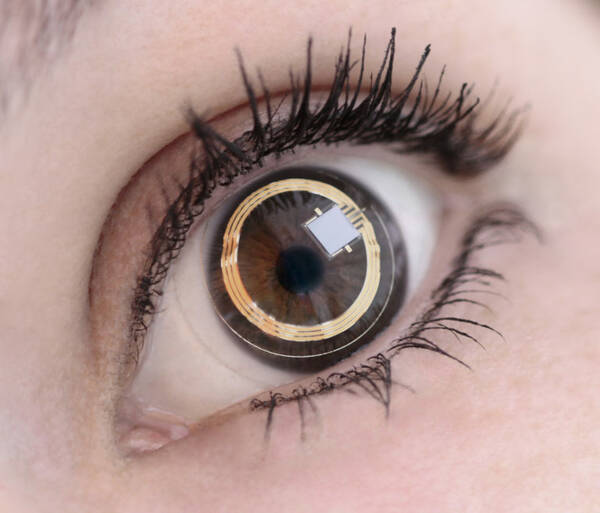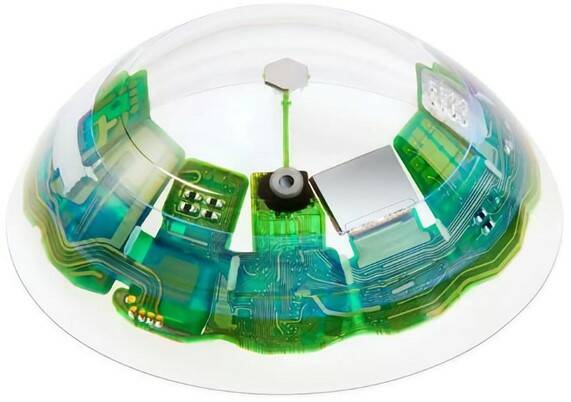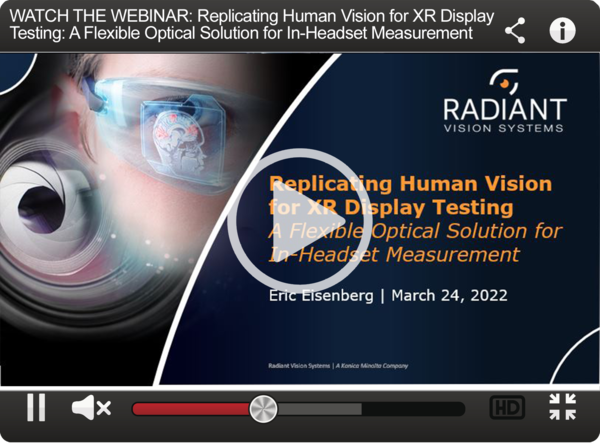AR Contact Lenses Bring the Metaverse Close Up
The earliest mainframe computers could fill an entire room. More than half a century later, innovation in electronics and computing has led to increasing miniaturization of components. Today, it’s possible to make tiny display devices that measure <5 mm across. Some of the most intriguing new miniature displays are the size of the human pupil—and in some cases, that’s exactly where they’re designed to be used: as contact lenses.
An Old Idea Meets New Materials
The principle of correcting human vision by using a material in contact with the surface of the eye actually dates back to the 1500s when Leonardo da Vinci experimented with looking through water. In the 1930s, an American scientist came up with a glass and plastic combination lens that was the forerunner of the of contact lenses we know today.1 Contacts found commercial success in the 1950s and by the end of the 1960s could be made just 0.10 mm thick.2 Lens innovation continued for the next two decades with the introduction of soft lenses using hydrogel materials, multifocal and toric lenses to help people with presbyopia and astigmatism, and disposable lenses that offered increased convenience and hygiene.
In the 1980s, materials advancements enabled the development of extended-wear contacts that were light, high in water content, oxygen-permeable, and could safely and comfortably be worn even while sleeping. Tinted lenses also hit the market, promising to change the color appearance of the wearer’s eye—from a natural brown to a vivid blue, for example. Today, tinted contacts have become commonplace. They're used in movies to give actors monster or alien eyes, as part of costumes on Halloween, and for everyday cosmetic wear.

A vintage 1980s tinted contact lens advertisement: “Softcolors®. For The Eyes You Wish You Had Been Born With.” (Image © Ciba Vision)
From the late 1990s onward, silicone hydrogel (SiHy) became the material used by most contact lens manufacturers. This material allows up to five times3 more oxygen to pass through it, helping keep the eye feeling fresh and comfortable. Hydrogel materials also absorb more water, making the lenses very pliable to easily fit the shape of a wearer’s eye. For example, Bausch + Lomb released silicone hydrogel disposable soft lenses in 2020 that maintain 96% of their moisture for a full 16 hours of wear.4
Smart Lenses & Contact Lens Displays
The 21st century has seen the emergence of “smart” contact lenses—lenses with embedded electronics—which are being developed for medical applications beyond simple vision correction. For example, some new lenses can enhance the sight capabilities of patients with more severe visual impairment or blindness, or to treat retinopathy.5 Additionally, the U.S. Food & Drug Administration has approved a lens called Triggerfish® that continuously monitors changes in eye pressure and ocular volume, key indicators for treating glaucoma.

Smart lenses embedded with wireless sensors monitor eye pressure in patients with glaucoma. (Image © Sensimed)
Building on the electronic capabilities of smart lenses, a new application receiving a lot of attention is the use of contact lenses as displays, replacing standard AR/VR head-worn hardware devices with smart lenses worn right on the eye. Once perfected, contact lens displays will not only be more convenient and less intrusive than a pair of AR glasses, but can show images across a much wider field of view. Because a contact covers the entire retina, displayed images can fill the wearer’s entire visual range.
The market’s first AR contact lens product prototype is now ready for testing, made by Silicon Valley’s Mojo Vision. Their lens uses a microLED display, billed as “the world’s smallest at just 0.5 millimeters in diameter, and densest with a pixel-pitch of just 1.8 microns.”6 It boasts:
- 14,000 pixels per inch
- 5GH ultra-low-latency radio to stream AR content
- ARM processor
- Continuous eye tracking via custom-configured accelerometers, gyroscopes, and magnetometers
- Medical-grade in-lens batteries
- Eye-controlled user interface.
To operate, Mojo’s lenses connect via radio signal with an external controller that can be worn like a necklace.

The Mojo Vision prototype AR contact lens. (Image © Mojo Vision)
Another company, InWith, is working with Bausch + Lomb’s hydrogel contact lenses to develop “the world’s first soft smart contact lens.” 7 The lenses, shown at CES 2022, are designed to be disposable, and InWith CEO Michael Hayes estimates they will cost roughly twice the price of traditional disposable soft lenses.9 Like many traditional AR devices, the InWith contact lenses will work in conjunction with a user’s smartphone.
Close-up of the InWith contact lens and electronics. (Image © InWith)
AR/VR Contact Lens Applications
Theoretically, anything seen on your smartphone could be displayed via AR device whether headsets or contact lenses. The most common use case for these AR contact displays is the same as that for other AR devices like smart glasses: to display information such as navigation, communication alerts, time, and weather on a transparent surface with the background environment visible.
For people with visual impairments, the capabilities of AR/MR contact lenses can be a boon. Many traditional AR/VR hardware devices include systems to “map” the visual environment. Instead of using these maps to integrate with displayed information, the information about the real environment can then be presented back to the wearer to help them better “see” the world around them.
With their ability to fill the user’s complete field of view, some experts suggest that display contact lenses could also be used to create an immersive, VR-like experience. In the future, the metaverse may be quite literally right in front of our eyes.
Ensuring the Quality of XR Devices
What all types of AR, VR, and MR (collectively XR) optical systems have in common, whether hard glass screens or soft contacts, is a need for rigorous performance and visual quality testing. Images displayed directly in front of a wearer’s eyes must offer clarity and legibility without noticeable defects. Displays also need to avoid any latency, eye-to-eye discrepancies, or other issues that can create motion sickness or disorientation for the user.
Radiant offers several solutions to measure and inspect both AR/MR and VR displays. Used by some of the world’s leading XR device makers in both the R&D labs and on the production line, our ProMetric® Imaging Photometers and Colorimeters measure and quantify the brightness (luminance) and color (chromaticity) of display images as they are perceived by the human eye.
Our unique AR/VR Lens and patent-pending XRE Lens solutions are designed to provide the flexible, accurate, and repeatable measurements that near-eye display developers and manufacturers need to evaluate the performance of XR devices and components. From VR display screens to transparent AR/MR displays, waveguides and optical elements, and projected images at variable focal distances from 0.5 meters to infinity, Radiant systems help reduce the time and cost of testing XR products at all component stages to streamline time to market. To learn more, watch the webinar “Replicating Human Vision for XR Display Testing: A Flexible Optical Solution for In-Headset Measurement.”

CITATIONS
- Callan Smith-Shereen, “A brief history of contact lenses.” VisionDirect UK, July 18, 2017.
- Ibid.
- Ibid.
- “Bausch + Lomb launches daily disposable silicone hydrogel.” Primary Care Optometry News, September 9, 2020.
- Stephen J. Vincent, “The use of contact lenses in low vision rehabilitation: optical and therapeutic applications.” Clinical and Experimental Optometry, 2017 Sep; 100(5):513-521. doi: 10.1111/cxo.12562. Epub 2017 Jun 29. PMID: 28664572.
- John Koetsier, “Mojo Vision’s Smart Contact Lens: Ready for Real-World Testing.” Forbes, May 18, 2022.
- Andy Altman, “InWith promises world’s first soft smart contact lens.” CNET, January 9, 2022.
- Ibid.
Join Mailing List
Stay up to date on our latest products, blog content, and events.
Join our Mailing List
